Two fridays ago we had our friends Chris and Greta to dinner, and since Greta is a fabulous cook who worked in a great NYC restaurant before moving to NH, I wanted to try something new and really cook a great meal. I got my very own copy of Sunday Suppers at Lucques for Christmas, and decided to try Suzanne Goin’s short ribs recipe, and serve it with her parsnip-potato puree. To start I made another cauliflower soup, this time a recipe from Bon Appetit (I got a subscription for Christmas) with much more stuff in it. For dessert I tried my hand at another BA recipe, a caramel pudding tart in almond shortbread crust. That was topped with candied almonds and whipped cream. I basically cooked for a day and a half straight, but luckily everything came out very well.
for Christmas, and decided to try Suzanne Goin’s short ribs recipe, and serve it with her parsnip-potato puree. To start I made another cauliflower soup, this time a recipe from Bon Appetit (I got a subscription for Christmas) with much more stuff in it. For dessert I tried my hand at another BA recipe, a caramel pudding tart in almond shortbread crust. That was topped with candied almonds and whipped cream. I basically cooked for a day and a half straight, but luckily everything came out very well.
Thursday night I rubbed the short ribs in salt, pepper and herbs, as directed, and tucked them into the fridge to rest. I made the shortbread dough and put it in the tart pan, then froze that overnight. Friday morning I baked off the crust and candied the almonds, and after lunch I made the pudding and put the tart in the fridge to chill.
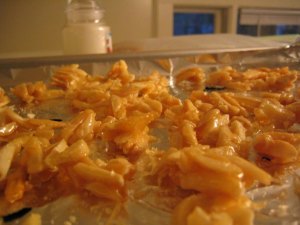
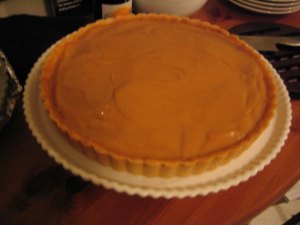
Then I pulled out the short ribs to warm up, broiled some pearl onions that would later be served with the ribs, and browned the ribs (I made 6, but couldn’t brown them all at once):

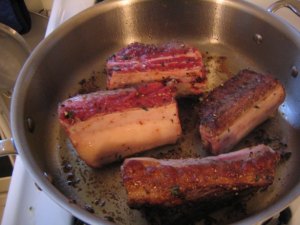
I made a mirepoix, cooked down red wine, port and balsamic vinegar, squeezed all the ribs in, and then….oh, then. Goin’s instructions say to cover the braising pot tightly with PLASTIC WRAP, then with tinfoil. She very carefully says not to worry, that it’ll be fine in the oven. I was dubious, to say the least, but this is the woman responsible for the pork burgers that are so complicated but come out so perfectly, so I trusted her. I put the pot in the oven and ignored it for over three hours.
Meanwhile I cleaned two huge bunches of red chard (there wasn’t any swiss in stock at the Coop, and I found the bright fuschia veins charming):
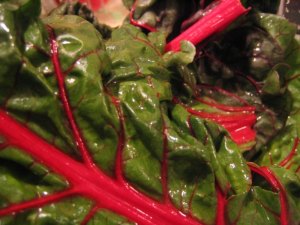
Then I made the parsnip puree, a relative nightmare since my Williams-Sonoma ricer likes to spray everything back out of the hopper, instead of through the screen. Awful. I and most of the kitchen was covered in hot potato and parsnip. This wasn’t helped by the fact that parsnips have lots of fibers, which clogged the ricer up terribly. I persevered, relieved that no one was home to hear me cursing or see me with parsnip on my nose, and the puree was very creamy and tasty, though not very different from straight potato. Finally, after Ben got home and was sent on an emergency chicken stock quest to the Coop, I made the soup.

Eh. As you can see, it’s got much more going on than the last version. It starts with bacon, and then celery and onion, and then the cauliflower and stock and a chunk of pecorino cheese. It was finished with “truffle oil” (we ended up returning it, it smelled/tasted like plain stale olive oil; obviously past the use by date) and shaved pecorino. It didn’t have as nice of a color, since the browned bacon and fat made everything browner. And the bacon was a little overpowering. I prefer the simpler version by quite a lot.
Just before Chris and Greta got to the house I pulled out the short ribs to see how they were doing. Well, surprise, surprise. The plastic wrap was visible fused to the outside of my Le Creuset, but inside: Nothing. It had vanished, obviously melted into the ribs. My stomach dropped into the basement, and I yelled for Ben to help me fish out the sheets of plastic wrap we could find. I was pretty freaked out–we didn’t find much, and I didn’t know what to do. In the end I admitted what had happened to Greta, and we just…served it. No one choked or got sick, so all’s well that ends well? I guess. Anyway, NO PLASTIC WRAP in the OVEN. After letting the ribs rest while we all got drinks, etc., I cranked up the oven to brown the ribs while the braising liquid reduced a bit.
I served the soup, which was good but not fantastic:
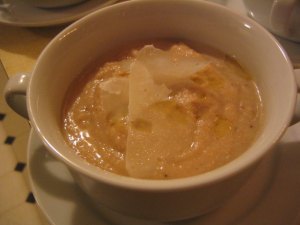
Then cooked the chard with the pearl onion, heated up the puree and put it in a serving bowl, heated up plates and plated everything:

I have to say the ribs were fantastic. The chard and onions provided great contrast, the sauce from the braising liquid was incredibly rich and flavorful, and the meat was meltingly tender and very, very delicious. It was a huge production, but at least I’d picked the right people to cook it for–Greta said short ribs are their favorite meat. (When I discussed the menu with my mom she was hesitant about the ribs because they’re so prehistoric-looking and fatty, until I told her where Greta had worked, and she said “oh, it’s perfect!”) The puree was a nice counterpoint too, as was a horseradish crème fraîche that Goin recommends serving with the meat.
It was a long time before we were able to face dessert, but that was a hit too. It was too sweet for me but the guys especially loved it. (Ugh, WAY too sweet for me.)
A messy photo:
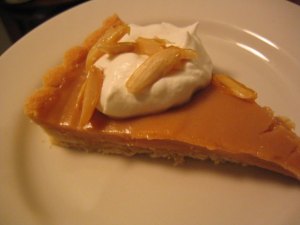
It was actually really fun to go all-out on a menu, and I am in love with the Lucques cookbook, though the plastic wrap thing threw me. Soon we will be trying Grilled Pork Confit! Liz has 2 quarts of duck fat coming our direction!









































